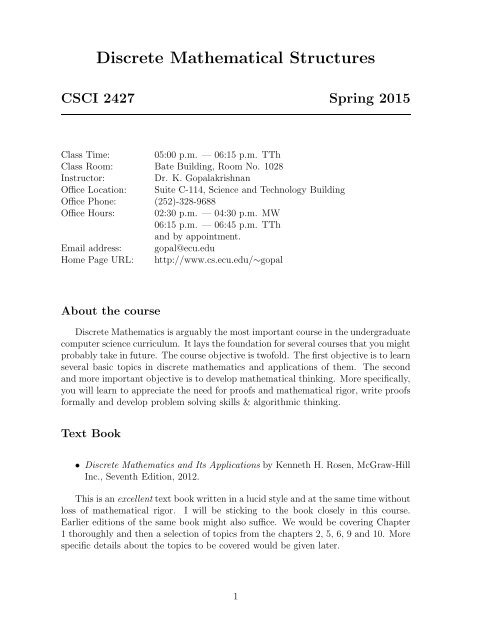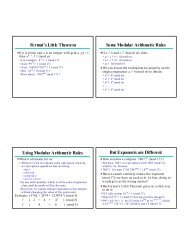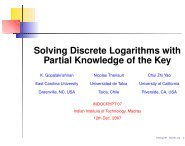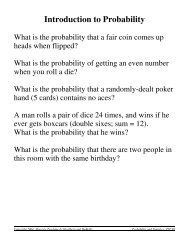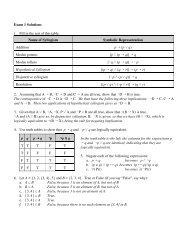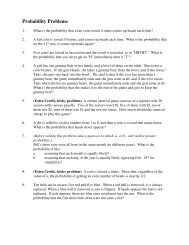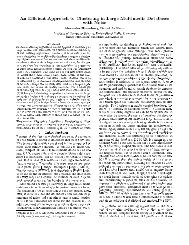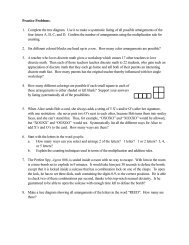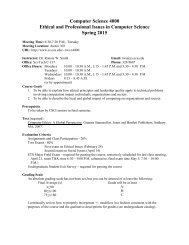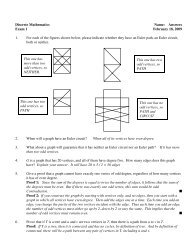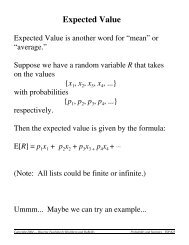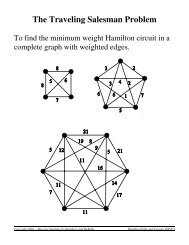Discrete Mathematical Structures - Computer Science
Discrete Mathematical Structures - Computer Science
Discrete Mathematical Structures - Computer Science
You also want an ePaper? Increase the reach of your titles
YUMPU automatically turns print PDFs into web optimized ePapers that Google loves.
<strong>Discrete</strong> <strong>Mathematical</strong> <strong>Structures</strong><br />
CSCI 2427 Spring 2015<br />
Class Time: 05:00 p.m. — 06:15 p.m. TTh<br />
Class Room: Bate Building, Room No. 1028<br />
Instructor: Dr. K. Gopalakrishnan<br />
Office Location: Suite C-114, <strong>Science</strong> and Technology Building<br />
Office Phone: (252)-328-9688<br />
Office Hours: 02:30 p.m. — 04:30 p.m. MW<br />
06:15 p.m. — 06:45 p.m. TTh<br />
and by appointment.<br />
Email address: gopal@ecu.edu<br />
Home Page URL: http://www.cs.ecu.edu/∼gopal<br />
About the course<br />
<strong>Discrete</strong> Mathematics isarguablythe most important course in theundergraduate<br />
computer science curriculum. Itlaysthefoundationforseveral coursesthatyoumight<br />
probablytake infuture. Thecourse objective is twofold. Thefirst objective isto learn<br />
several basic topics in discrete mathematics and applications of them. The second<br />
and more important objective is to develop mathematical thinking. More specifically,<br />
you will learn to appreciate the need for proofs and mathematical rigor, write proofs<br />
formally and develop problem solving skills & algorithmic thinking.<br />
Text Book<br />
• <strong>Discrete</strong> Mathematics and Its Applications by Kenneth H. Rosen, McGraw-Hill<br />
Inc., Seventh Edition, 2012.<br />
This isanexcellenttext bookwritten in a lucid style andat thesame timewithout<br />
loss of mathematical rigor. I will be sticking to the book closely in this course.<br />
Earlier editions of the same book might also suffice. We would be covering Chapter<br />
1 thoroughly and then a selection of topics from the chapters 2, 5, 6, 9 and 10. More<br />
specific details about the topics to be covered would be given later.<br />
1
Prerequisites<br />
• MATH 1065 College Algebra or an equivalent course.<br />
Grading Policy<br />
Your grade in this course will be based on your performance in Assignments and<br />
examinations. The weights for different components are given below.<br />
Exam I ...... 20%<br />
Exam II ...... 20%<br />
Final Exam ...... 25%<br />
Assignments ...... 35%<br />
Assignments must be taken seriously and must be submitted in time. There will<br />
not be any programming assignments in this course. Part of the assignments will be<br />
doneusingthewebbased“McGraw-Hill’sConnect”System(thatwillbeauto-graded)<br />
and the remaining part will be traditional paper based assignments.<br />
The details of the examinations are as follows. There will be two regular examinations<br />
during the semester and a final comprehensive examination at the end of<br />
the semester. The exact dates for the regular examinations will be announced later.<br />
The final examination will be held as per the university examination schedule. You<br />
will not be allowed to use your books or notes in examinations. However, you may<br />
use non-programmable calculators and a crib sheet. Make up examinations would be<br />
given only under truly exceptional circumstances and only if arrangements for such<br />
is made prior to the regularly scheduled examination.<br />
The tentative guidelines for grades are:<br />
≥ 85 A<br />
≥ 80 and < 85 A−<br />
≥ 77 and < 80 B+<br />
≥ 72 and < 77 B<br />
≥ 69 and < 72 B−<br />
≥ 66 and < 69 C+<br />
≥ 61 and < 66 C<br />
≥ 58 and < 61 C−<br />
≥ 56 and < 58 D+<br />
≥ 52 and < 56 D<br />
≥ 50 and < 52 D−<br />
< 50 F<br />
2
McGraw-Hill’s Connect<br />
McGraw-Hill’s Connect is a web-based assignment and assessment solution required<br />
for this course. Connect is designed to assist you with your coursework based<br />
on your needs. As outlined in the grading policy, assignments will make up a significant<br />
portion of your overall course grade.<br />
Connect access codes may be packaged with a new textbook in the bookstore.<br />
Connect can also be purchased online at our section’s unique Connect web address:<br />
http://connect.mheducation.com/class/k-gopalakrishnan-sp15. If you purchase<br />
Connect online, you will have the option of purchasing Connect or Connect<br />
Plus, which includes an interactive eBook version of the required textbook for this<br />
course. You can also register in Connect and have access without a code for a limited<br />
time period (typically three weeks).<br />
To register in Connect, please visit the following web site and click “Register<br />
Now”: http://connect.mheducation.com/class/k-gopalakrishnan-sp15<br />
If you have any issues while registering or using Connect, please contact McGraw-<br />
Hill’s Customer Experience team through http://www.mhhe.com/support or at 800-<br />
331-5094. To avoid problems related to technical issues, you are advised not to wait<br />
until the last moment to complete assignments. Please review your “Connect Student<br />
Quick Tips” document for further support.<br />
Learning Outcomes<br />
As the course consists of many different discrete topics, the student would have<br />
acquired many different skills by successfully completing the course. Here is a list<br />
(non-exhaustive) of some of the skills.<br />
• Translate English Sentences into Propositional Logic and vice versa.<br />
• Translate English Sentences into Predicate Logic and vice versa.<br />
• Determine whether two given logical expressions are equivalent or not.<br />
• Determine whether a given logical argument is valid or not.<br />
• Determine whether a given mathematical proof is correct or not.<br />
• Construct simple mathematical proofs using standard techniques.<br />
• Prove universally quantified statements using <strong>Mathematical</strong> Induction.<br />
• Model word problems using set theory and solve them.<br />
• Identify whether a given mapping is a function and if so, is it 1-1 and onto.<br />
3
• Compose functions and determine inverse functions when feasible.<br />
• Countthenumberofarrangementssatisfyingcertainspecificationsusingvarious<br />
principles of elementary combinatorics.<br />
• Determine properties of a given relation<br />
• Model real life problems using graph theory and solve them.<br />
4


